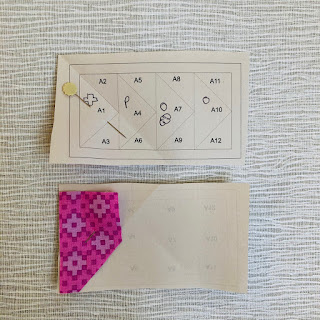Foundation pieced flying
geese
Materials:
2.5” to 3” squares of background fabric cut into triangles
Assorted scraps for geese measuring at least 2.5” by 4.5” but don’t cut your pieces down to this size as you will trim as you go
Foundation paper
Download the foundation pattern here. Print the foundation pattern onto paper. I use Jenny Doak’s foundation paper which I buy from Amazon. I buy the cheapest size and print in greyscale at actual size. Measure the 1” box before continuing. I then mark on the paper the colour fabric that I want for each goose. Don’t use a Frixion pen as you will lose the markings when you press your work.
Then cut apart the paper patterns leaving a
good quarter inch around the dark cutting line.
You are ready to start sewing. The first section
is potentially the trickiest but after that you just follow the numbers.
Take your first
geese fabric and place it on the wrong side of the foundation pattern, face up. Pin
on the right side parallel to the stitching line between A1 and A2. Fold back
the foundation along the stitching line between A1 and A2. Trim the fabric ¼”
away from the line of the paper.
Place a
background triangle of fabric face down on your geese fabric, matching the edge
of the background triangle to the geese triangle. Keeping a firm hold of the fabric, turn over
and pin perpendicular to the line between A1 and A2.
Turn your stitch length down to 1.6 as the
paper will be perforated and much easier to remove. Stitch along the line between
A1 and A2. Starting in the seam allowance and continuing into piece A4. Press
the fabric away from A1 and double check the darker fabric isn’t showing in the
background. If it is, this is the time to grade the seam by trimming the seam allowance
of the darker fabric.
Now it’s time to repeat your actions for
piece A3. Remember the mantra – trim, stitch, press, repeat.
Fold the paper
back on the line between A1 and A3. You may tear some of the paper, but don’t
worry that will make the removal of the paper easier. If you rip too hard, use a scrap
of foundation paper and a glue stick to repair the tear, don’t use sticky tape,
it won’t end well!! Trim the fabric ¼” away from the line of the paper. Place a
background triangle of fabric face down on your geese fabric, matching the edge
of the background triangle to the geese triangle. Keeping a firm hold of the fabric, turn over
and pin perpendicular to the line between A1 and A2.
Stitch along the line between A1 and A3. Starting
in the seam allowance and continuing into piece A4. Press the fabric away from
A1 and double check the darker fabric isn’t showing in the background.
Instead of
pressing you can use a wallpaper seam roller but definitely press with an iron
once the unit is completed. Repeat the sequence – trim, stitch, press, repeat until you have sewn all
twelve sections. This is a good leader and ender project.
Press the finished block and trim to 4½ x 2½ inches. Sometimes the paper shrinks slightly when pressing, so just make sure you cut to the correct size.
Wait to sew sections together until you have a better idea of what size you need, but this block would look great as a rainbow. For the SAL bag pattern, I used one 2 x 4” strip and one 2” x 6” strips.
Visit our designers on Instagram to see their versions of this block : @cotefleurie @getahashtagkim @JustSewSue @lisasew @metroquilter @picosailors @pippaspatch @quirkyhannah @surfseasew @therunninghare
#scrapbagsampler












2 comments:
Thank you cannot wait to start.
Thanks for this fabulous sewalong, I love all my scraps and plan to make a 4" and a 6" strip otherwise I know I'd struggle with fitting them together at the end x
Post a Comment